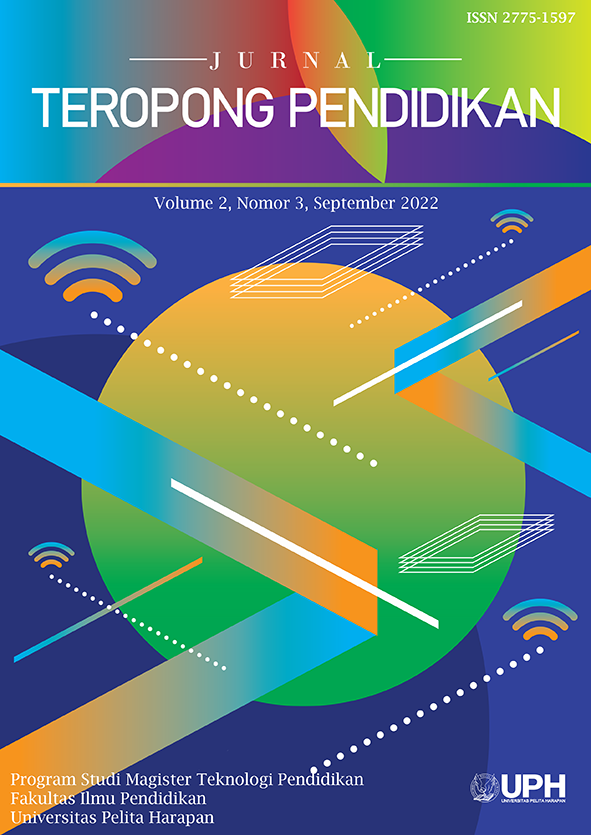Meningkatkan Jiwa Kewirausahaan Siswa dari Faktor Kompetensi Rasa Ingin Tahu, Berpikir Kreatif, dan Sikap Mengambil Risiko di SMA Lentera Harapan Tangerang [Improving Students' Entrepreneurial Spirit from the Competency Factors of Curiosity, Creative Thinking, and Risk Taking at Lentera Harapan Tangerang High School]
DOI:
https://doi.org/10.19166/jtp.v2i3.5725Λέξεις-κλειδιά:
Curiosity, creative thinking, risk-taking attitude, entrepreneurial spiritΠερίληψη
The entrepreneurial spirit is now needed. Through the entrepreneurial spirit, the students are expected to become skill and applicable in the daily life. Things that encourage the growth of the entrepreneurial spirit of the students are the curiosity competency, creative thinking and risk-taking attitude. Therefore, this study was conducted to determine whether there is a correlation and influence between the three competences toward the entrepreneurial spirit of the students, and to analyze how significant the influence of them. This study was implemented to 115 students of Lentera Harapan, Tangerang. Collecting data used questionnaire for the competences and entrepreneurial spirit by using SPSS statistical program assistance type 16. To solve the validity types, relationships, and influences is calculated by the formula Pearson and regression, and reliability using Cronbach Alpha. The result of this research showed that there is a correlation and influence between the curiosity competence (0.33), creative thinking (0.19), and risk-taking attitude (0.36) toward the entrepreneurial spirit of students. The three factors are influence toward entrepreneurial spirit as 0.422 and significant to develop the entrepreneurial spirit between the grade X and XI.
Αναφορές
Arasti, Z., Falavarjani, M. K., & Imanipour, N. (2012). A study of teaching methods in entrepreneurship education for graduate students. Higher Education Studies, 2(1), 1-10. https://doi.org/10.5539/hes.v2n1p2
Arikunto, S. (1998). Prosedur penelitian: Suatu pendekatan praktek. PT Rineka Cipta.
Cash, R. M. (2011). Creative thinking: Stepping outside the box. In Advancing differentiation: Thinking and learning for the 21st century (pp. 150-160). Free Spirit Publishing Inc.
Daryanto. (2012). Pendidikan kewirausahaan. Gava Media.
Fraenkel, J., Wallen, N., & Hyun, H. (2012). How to design and evaluate research in education (8th ed.). McGraw-Hill Companies, Inc.
Hamdi, A. S. (2014). Metode penelitian kuantitatif aplikasi dalam pendidikan. Deepublish.
Hayden, M., & Thompson. (2011). Taking the MYP forward. John Catt Publication.
Hennessey, B., & Amabile, T. (2010). Creativity. Annual Review of Psychology, 61, 569-598. https://doi.org/10.1146/annurev.psych.093008.100416
Isjoni. (2009). KTSP sebagai pembelajaran visioner. Alfabeta.
Koh, H.C. (1996). Testing hypotheses of entrepreneurial characteristics: A study of Hong Kong MBA students. Journal of Managerial Psychology, 11, 12-25. https://doi.org/10.1108/02683949610113566
Kuncoro, M. (2007). Metode kuantitatif teori dan aplikasi untuk bisnis dan ekonomi. UPP STIM YKPN.
Meredith, G. (2002). The practice of entrepreneurship (Kewirausahaan: teori dan praktek). International Labour Organization.
Mossing, S. (1997). The importance of creative thinking and the arts in education. Honors Project, 37. https://scholarworks.bgsu.edu/honorsprojects/37
Musrofi. (2004). Kunci sukses berwirausaha. PT Elex media Komputindo.
Mustari. (2014). Nilai karakter: Refleksi untuk pendidikan. PT Rajagrafindo Persada.
Ohira, N. (2013). Pengembangan rubrik penilaian proposal penelitian mahasiswa pada program studi tadris biologi jurusan Tarbiyah Stain Kerinci [Thesis, Universitas Negeri Padang]. https://www.academia.edu/5555386/Tesis_Norman_Ohira_PDF
Rasyid, H., & Mansur. (2012). Penilaian hasil belajar. CV Wacana Prima.
Santoso, S. (2016). Panduan lengkap SPSS versi 23. PT Elex Media Komputindo.
Sekaran, U. (2003). Research methods for business: A skill-building approach (4th ed.). John Wiley & Sons.
Sugiyono. (2003). Metode penelitian bisnis. Alfabeta.
Sugiyono. (2008). Metode penelitian kuantitatif kualitatif dan R&D. Alfabeta.
Sugiyono. (2014). Metode penelitian kuantitatif, kualitatif, dan kombinasi (mixed methods). Alfabeta.
Tim penyusun Kamus Pusat Bahasa (2005). Kamus besar bahasa Indonesia. Balai Pustaka.
Undang-Undang Republik Indonesia Nomor 20 Tahun 2003 tentang Sistem Pendidikan Nasional.
Wahyuni, S., & Ibrahim, S. (2012). Asesmen pembelajaran bahasa. Refiko Aditama.
Λήψεις
Δημοσιευμένα
Τεύχος
Ενότητα
Άδεια
Authors who publish with this journal agree to the following terms:
1) Authors retain copyright and grant the journal right of first publication with the work simultaneously licensed under a Creative Commons Attribution License (CC-BY-SA 4.0) that allows others to share the work with an acknowledgement of the work's authorship and initial publication in this journal.
2) Authors are able to enter into separate, additional contractual arrangements for the non-exclusive distribution of the journal's published version of the work (e.g., post it to an institutional repository or publish it in a book), with an acknowledgement of its initial publication in this journal.
3) Authors are permitted and encouraged to post their work online (e.g., in institutional repositories or on their website). The final published PDF should be used and bibliographic details that credit the publication in this journal should be included.





